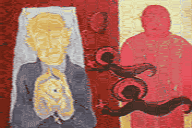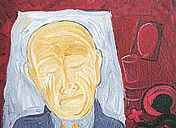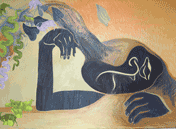



Ruckus Spiritualis
Where did we get the idea that spirituality is easy? Though it's comforts are undeniable, it is equally true that spirituality is a rough sport. These paintings show what can happen when religion and culture meet in the same arena. Are they evenly matched, or does the contest dissolve into cognitive dissonance? In my work, racism and sexism meet spirituality head on in a struggle; the resolution of these encounters is ambiguous at best. Red Grooms' satire and Jacob Lawrence' vernacular are influences which are evident in my paintings.
In the "Racist" series, social commentary
is presented within a cross-cultural context. The titles are revealing: "Salvation Offered to the Racist by African Saints and Angels;" "Salva- tion Offered to the Racist by European Saints and Angels;' "Salvation Offered to the Racist by Asian Saints and Angels." Here we are confronted by the question: when offered help, will we accept it if it comes packaged in the 'wrong' cultural wrappings? Are we likely to accept help only when it comes from within our own culture? It's a comment on how we will limit ourselves to a ludicrous degree.
When the word salvation is used, our expectations are raised for a happy outcome. However, when salvation is offered to a racist by someone outside their race, do we assume
a flat refusal? Do we presuppose culture will override religion, the outcome of the contest between culture and religion already decided? Note in "Salvation Offered to the Racist by African Saints and Angels," the angels and saints have African features. It upends our expectations for salvation, as something narrowly confined within religiosity's parameters. Yet, salvation is never static; a response is implicit. If acceptance, then action is required to penetrate outside the narrow, cultural comfort zone. A look, a gesture, is all that may be required, but a response is necessary to obtain the salvation offered.In the 'Racist' series, the picture plane is divided in half, between the spiritual and the temporal, with angels of specific ethnic category bridging the gap. There is tension as they extend their offerings. Will they be rejected? Time is evoked--has the moment passed? Has the subject responded? Ambiguity is in the representation of where the subject rests. Is that a coffin or a bed? If it's a coffin, is it too late? Or if the offer is being made after death, perhaps there's no such thing as too late. Perhaps the question is--when it comes to God's mercy--is there ever such a
thing as being too late? The rosary beads in
the racist's hand imply that he is already familiar with the traditions of religion, perhaps already 'saved.' The inference here is that salvation is multilayered, and piety not enough; the
social dimension, cannot be neglected.The angels are almost cartoon-like, yet the witty handling of the subject undercuts the seious- ness of the business at hand. Is this meant to be
a humorous moment? The titles would belie that. Upon further reflection, perhaps cartoon-like elements are appropriate; only a buffoon would refuse help in their last moments. Is our society able to at last recognize the racist, pursued by imaginary fears, as the real figure of fun? Has the racist at last become the lugubrious figure it deserves to be?
There are more questions. Do we even know what the word salvation means? Is it one of those overused words to which we've become accustom- ed, its meaning lost? Should the word, salvation, be mothballed as confined to images of traditional elements such as crosses, rosaries, and churches with spires? Is the word, liberation, the better choice? Are there are other symbols that can be used? What might these be? Are we limited by our images?
In the 'Eve Dreaming "series, the social commentary addresses sexist categories, by reversing the Creation story. Or rather, the Creation story is corrected. After all, it is women who bring life into the world. It is patriarchy that insists on reversing the natural order in the Creation story, giving the man for the first and only time the role of progenitor. This painting restores and corrects. Here, it is the woman who dreams, rather than the man. It is from her dreaming head that a cascade of animals emerges. There is no sign here of the man, or a rib. As she dreams, her creativity is unleashed. Like racism, it is patriarchy's sexist categories that limit our spiritual horizons, and inhibit our ability to live full lives.
The influence of Red Grooms is evident in these paintings. Despite the traditional subject matter, there is tumult in the friction between religion and culture. They have more in common with Red Grooms "Ruckus Manhattan," than liturgical art. His city scenes are like a volcano bursting with the energy and vitality of New York. In my work, major saints erupt from out of the living room floor; water spurts and fills the room from a giant rock. Like Grooms, the paintings combine representation with story telling. In the "Living Room" series, I bend history within the narratives, placing spiritual giants of past centuries within contemporary, homely settings. Traditional spirituality would say those who have passed on are not tethered to time or place and so are not out of place there. The visitors explode into view, yet the occupants are unperturbed. Could it be that these visitors are expected? Like Grooms, who "sees his subject mostly in its social relationships or inter- actions," the crux is the subjects' interactions with their visitors as well ( Perrell 2). In my work, there is serenity within the chaos.
Jacob Lawrence's influence is seen in my paintings in the flattened picture plane as well as the choice of bright colors. Figures are exaggerated and abstracted. Faces are masks. His vernacular is
also seen in the interiors, such as living rooms and bedrooms, intimate spaces where people can be themselves. In the "Living Room" series, the tensionof the 'Racist's series is missing. Spiritual and temporal spaces do not have to be bridged, they reside peacefully with each other. It is in our intimate spaces that we can let down our guard and let go, where anything can and does happen. Within these comfort zones, surrender is more likely. And within this surrender, occupants of the spiritual zone may enter. Note how they are juxtaposed next to mundane item of our American culture, a TV set. It's a comment on how the sublime and the ordinary reside next to each other.
Jacob Lawrence's influence is seen in my paintings in the flattened picture plane as well as the choice of bright colors. Figures are exaggerated and abstracted. Faces are masks. His vernacular is also seen in the interiors, such as living rooms and bedrooms, intimate spaces where people can be themselves. In the "Living Room" series, the tension
of the 'Racist's series is missing. Spiritual and temporal spaces do not have to be bridged, they
reside peacefully with each other. It is in our intimate spaces that we can let down our guard and let go, where anything can and does happen. Within these comfort zones, surrender is more likely. And within this surrender, occupants of the spiritual zone may enter. Note how they are juxtaposed next to mundane item of our American culture, a TV set. It's a comment on how often the sublime and the ordinary reside next to each other.
Invisible worlds are evoked both in my work and Jacob Lawrence's paintings. It could be said that Lawrence's objective was to make visible the African American community around him, a community that was 'invisible' to whites and considered unremarkable, by their black inhabitants. My paintings make visible the invisible interactions of heaven with earth within the intimate settings of living rooms and bedrooms. His "pictures of African American normalcy carried Lawrence's inquests into community life to a higher, more challeng-ing level of cultural representation" (Nesbett and Dubois 155-6). The normalcy invoked in my paintings is the interactions between heaven and earth. The subject may or may not look at the other worldly being emerging from the floor. Their normalcy is their familiarity with each other, as if it is a reoccurring phenomenon.
In the conflict between religion and culture, I take the stance of artist-provocateur. Like the work of Red Grooms, my paintings are a satiric comment on
human weakness, whether it be sexism, racism or
the persistence of patriarchy within our culture. "Grooms' social conscience becomes evident in the caricature manner in [his portrayals]" (Perrell 4). The artist conscience is evident within my work, making visible our social conventions as a goad and prod.Works Cited
Nesbett, Peter T. and Michelle DuBois. Over the Line The Art and Life of Jacob Lawrence. Univ Washington. 2000 155-156.
Perrell, Franklin Hill. Red Grooms. http://www.tfaoi.com/aa/6aa/6aa160c.htm